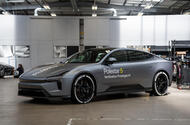Unlike the new Emeya, the upcoming Polestar 5 has the engineering hallmarks of an old-school Lotus
A fews week ago I was in Austria to have a go in the Lotus Emeya – an electric super-saloon with as much as 904bhp and a good dollop more interior space than you get in the Porsche Taycan, especially in the back.
If you can make peace with the fact that it’s a Lotus that treads as heavily as a V8 turbodiesel-equipped L322-generation Range Rover (not easy, I'll admit), the Emeya is actually quite a decent thing. It's no reincarnated Carlton but it has some likeability about it.
And yet, out in the Tyrolean wilds, with the Emeya S (that’s the less powerful one, with a pitiful 603bhp) making a fair case for itself with fine steering and fluid handling, as a product it still had the whiff of a pulled punch about it. I couldn’t put my finger on why, but I have done since. It’s partly down to…Volvo.
Well not Volvo strictly but Polestar, which began life as the Swedish marque's performance EV subsidiary (but is now a standalone firm within the Geely empire).
Polestar will soon release its own Taycan competitor in the form of the snouty 5. As a purely electric car, it'll be horribly heavy, just like the 2.5-tonne Emeya. However, unlike the Emeya, it’s being developed in the UK, by a crack team of engineers who have devised for it a bonded-aluminium chassis with ‘supercar’ stiffness.
This team, based at the MIRA proving ground near Nuneaton, has also been given free reign to develop the axle and steering systems from the ground up. The car will be low-slung and deliberately devoid of complex, electronics-reliant hardware, such as active anti-roll bars, rear-steering and air springs, all of which the Emeya gorges on.
The 5 will be an unusual Polestar in that it sets out to be a seat-of-your-pants drivers’ car. The conception sounds quite Lotusy, too, doesn’t it?
In a way, the 5 will be a four-door Evora EV. And this is where things get perplexing. Volvo and Polestar are ultimately controlled by Chinese conglomerate Geely. The same company also owns Lotus. All three brands exist under the same umbrella, so any resource developed by one entity to one can be made available to another.
What I’m therefore wondering is why the unapologetically design-led Polestar brand is taking a bespoke, purist engineering approach for its Taycan fighter while the Emeya, coming from a company whose name has hitherto been synonymous with machines of unfettered synaptic delight, has ended up sharing its platform, albeit modified, with the Zeekr 009 and the Smart #1.
The Emeya is good – better than many will judge it to be, having never even driven it. But it could have been considerably more Lotusy if the team behind it (based near Frankfurt, as it happens, not Hethel) had been allowed to take the 5 approach. Or at least use the 5 platform.
Instead, what’s happened seems akin to Audi being allowed to develop a clean-sheet honey of a chassis for the TT while Porsche has to adapt a VW Golf platform for the Boxster. Make it make sense.Â

